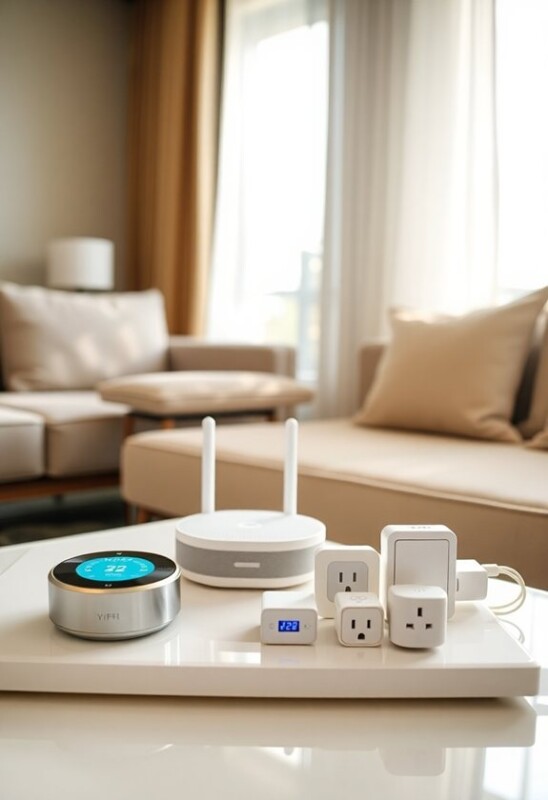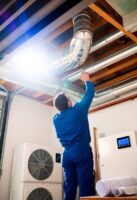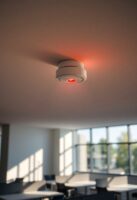Modern power gadgets cut your apartment’s energy costs through intelligent monitoring and automation. You’ll reduce waste with smart plugs that control device clusters and LED bulbs that use 75-90% less electricity. Automated thermostats learn your schedule while eliminating HVAC inefficiencies, and advanced power strips target energy vampires that drain power on standby. Real-time tracking helps you identify consumption patterns and optimize settings for maximum savings. Understanding these technologies reveals even greater efficiency potential.
Key Takeaways
- Smart plugs eliminate vampire power drain and allow remote control of multiple devices, reducing unnecessary energy consumption in small spaces.
- LED bulbs consume 75-90% less energy than traditional bulbs and last 25 times longer, providing significant long-term cost savings.
- Smart thermostats learn household patterns and automatically adjust temperatures, cutting HVAC energy costs by up to 15% annually.
- Advanced power strips with master-controlled outlets prevent standby power waste from electronics clusters, saving up to $200 yearly.
- Real-time energy monitoring helps identify peak usage periods and wasteful consumption patterns for immediate cost-saving adjustments.
Making Smart Plugs Work in Small Spaces
While living in compact spaces presents unique challenges for smart home integration, strategic placement of smart plugs can improve both functionality and energy savings.
You’ll optimize smart plug benefits by positioning them behind furniture without blocking adjacent outlets, ensuring efficient use of limited socket space.
These compact automation tools connect directly to Wi-Fi, eliminating the need for extra hubs in your tight quarters.
You can manage multiple device types through a single plug while monitoring their energy consumption.
The Truth About LED Lighting Savings
Although LED lighting technology requires a higher upfront investment, the compelling data reveals transformative energy savings that dramatically outperform traditional lighting solutions.
LED longevity extends up to 25 times beyond incandescent bulbs, while delivering 75-90% greater energy efficiency.
You’ll slash your lighting-related energy consumption from 15% to just 5% of household use. By replacing just 10 traditional bulbs with LEDs, you’ll reduce annual energy costs from $215 to $36.50 at average rates.
When combined with smart features like automated scheduling and brightness control, LEDs offer precise energy management that can save you $4,000 over two decades.
Setting Up Automated Temperature Control
Once you’ve experienced the convenience of automated temperature control, you’ll wonder how you managed without it.
Smart scheduling dramatically reduces energy waste by adapting to your daily routines and user preferences. Through smartphone apps, you can remotely adjust settings and utilize geofencing technology that automatically responds to your location.
The system’s learning algorithms optimize comfort while cutting energy costs by 15%. You’ll save up to $135 annually through precise HVAC integration and automated adjustments during sleep or away periods.
Connect with other smart home devices through voice assistants for centralized control, making temperature management effortless and efficient.
Power Strip Strategies for Electronics
Smart temperature control takes care of your HVAC system, but managing electronics’ power consumption requires a likewise intelligent approach.
Advanced power strips (APS) target energy vampires in your home through master-controlled outlets and auto-shutoff features.
Strategic power strip placement near device clusters enhances effectiveness. You’ll want to position strips accessibly while avoiding cord strain and ensuring proper surge protection for sensitive electronics.
Energy vampire identification is essential – focus on gaming consoles, chargers, and entertainment systems that draw standby power.
With smart USB ports and motion sensors, these strips can reduce your annual vampire load costs by $200 while protecting your devices from surges.
Best Window Solutions for Energy Control
While traditional windows account for significant energy loss, modern technological solutions offer precise control over heat transfer and solar gain.
Smart glass benefits include automated transparency adjustments based on weather conditions, reducing HVAC dependency through intelligent insulation. You’ll find low-e coatings particularly effective, reflecting heat inward during winter while minimizing solar gain in summer.
Gas-filled systems using argon or krypton between panes deliver superior thermal performance, while integrated sensors optimize passive heating and cooling.
For cost-effective improvements, consider low-e storm windows or exterior shades, which can reduce cooling costs by up to 20% and seamlessly integrate with smart home automation systems.
Real-Time Energy Tracking Benefits
By implementing real-time energy tracking systems, you’ll gain unprecedented visibility into your power consumption patterns and access significant cost-saving opportunities. Your data-driven insights enable dynamic adjustments to usage patterns, while identifying peak consumption periods allows you to shift energy-intensive activities to off-peak hours.
| Benefit | Impact |
|---|---|
| Cost Control | 9-23% HVAC savings |
| Smart Automation | 50% standby power reduction |
| Maintenance | Early failure detection |
| Sustainability | Lower carbon footprint |
You’ll optimize equipment lifespan through predictive maintenance, while automated controls align your energy consumption with actual occupancy needs. This precision monitoring empowers you to make informed decisions about energy-efficient upgrades and participate in demand response programs for extra savings.
Combining Devices for Maximum Savings
Three key device combinations can enhance your home’s energy savings potential: HEMS integration with grid-enabled appliances, smart power strips coordinated with occupancy sensors, and layered program incentives for upgraded equipment.
Your HEMS’s device compatibility enables thorough energy monitoring across multiple systems, while grid-enabled appliances respond to utility signals during peak periods.
By connecting smart power strips to occupancy sensors, you’ll eliminate vampire loads when rooms are vacant.
You can increase savings by layering utility incentives for equipment upgrades – just verify program eligibility and caps.
This coordinated approach delivers higher efficiency than standalone solutions.
Conclusion
Smart energy solutions for your apartment require strategic integration of multiple devices. You’ll optimize savings by combining smart plugs, LED lighting, automated thermostats, and power strips into a cohesive system. Real-time monitoring lets you track consumption patterns and adjust accordingly. Window treatments complete your energy management strategy. By implementing these technologies systematically, you’re looking at potential savings of 10-30% on monthly utility costs.



